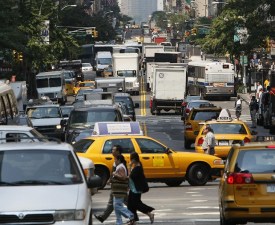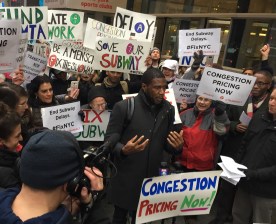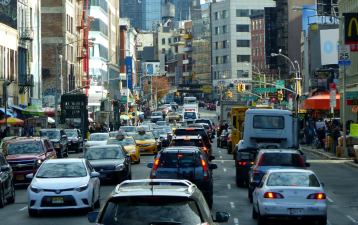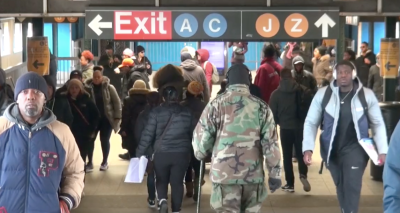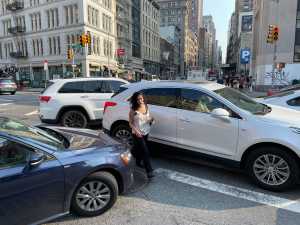THE BRUUUUCE EXCUSE: Jersey Pol Cites Springsteen as a Reason to Oppose Congestion Pricing
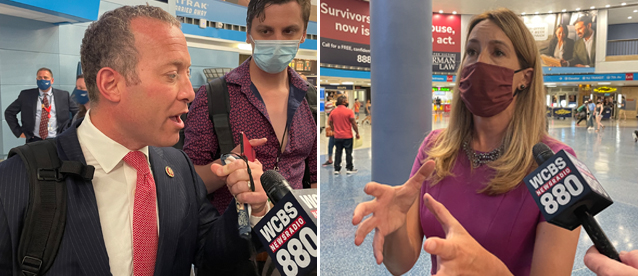
Them gasoline boys in Jersey sure talk gritty, it’s so hard to be a driver in the city.
Garden State politicians are such blood brothers to New Jersey’s semi-official bard and his mythical beaten-down blue-collar last man standing that now they’re using him to justify trying to kill congestion pricing in the real world.
“Springsteen’s on Broadway, so everyone in New Jersey is going to Broadway and people [are] having a lot of trouble now for the first time really getting in and out of the city,” Rep. Mikie Sherrill (D-N.J.) said this week about her constituents driving in to see a show whose tickets basically start at $250, but typically cost hundreds more.
A fellow member of the New Jersey delegation walked into a similar 10th Avenue freeze out of the plan to toll drivers to enter Manhattan below 60th Street.
“It would be great if we had mass transit option for people in my district so that everybody can take mass transit, but that’s impossible,” congestion pricing foe Rep. Josh Gottheimer (D-N.J.) added in an effort to explain why he says Johnny bye-bye to the MTA’s necessary fundraising lifeline. “Have you come to my district? Sussex County and Warren County and parts of Bergen County where there’s no mass transit? Go tell a nurse who’s working the late shift that they’ve gotta come over [on mass transit].”
Leaving aside the fact that there’s a NJ Transit line named the Bergen County Line that goes to city-bound transfer points Secaucus Junction and Hoboken, and that the median household income in the congressman’s district is $110,000 per year (that’s mansion on a hill territory), the Regional Plan Association and former New Jersey Gov. James Florio have pointed out that only about 20,000 drivers per day go down to the river, over the George Washington Bridge, and then into the fire of the congestion pricing zone (which could lead them right into an incident on 57th Street).
Additionally, old research from the Tri-State Transportation Center puts the pols’ argument on rocky ground: less than 1 percent of Warren County residents, the one piece of Gottheimer’s district untouched by NJ Transit, drove themselves into an earlier congestion pricing zone, aka the promised land south of 86th Street. Nonetheless, Gottheimer sang the opposite of a New York City serenade.
“We’ve got to do whatever we can to stop congestion pricing. It’s a tax on New Jersey,” he said point blank.
Sherrill posited that congestion pricing would actually make it harder for New Jersey to fix a mass transit system that it allowed to turn into a city of ruins in the late 2000s.
“I don’t like the congestion pricing plan as it is, I don’t think it’s a net benefit to New Jersey. When you hear the great sucking sound from New York, it’s hard to invest in your own infrastructure issues in Jersey, which I think would ease the amount of cars on the road,” she said, offering no surrender and a reminder that in Jersey, they take care of their own.
The easy money suggests that the two hearts — Gottheimer and Sherrill — are working the refs in order to get a toll credit for George Washington Bridge users who then drive south into the congestion zone. And perhaps there is even a case to be made that since drivers using the Lincoln and Holland Tunnels will likely be credited (they already pay a toll to get into the congestion zone), George Washington Bridge drivers should also be credited to reduce toll-shopping.
But every dollar the MTA gives out in toll credits to certain drivers means that other drivers will have to pay more to raise the mandated $1 billion from the toll. It might be “fair” to exempt people using one route or another, but exempting even 10 percent of trips into the congestion zone drops driver speeds by 7 percent and costs the MTA over $1 billion in transit improvement money, according to congestion pricing expert Charles Komanoff.
It’s a problem to solve no doubt, which is where you would think a member of the Problem Solvers Caucus like Gottheimer would attempt to find a workable solution beyond carping about how it’s impossible to provide better mass transit options for his constituents and suggesting that congestion pricing does “nothing” for New Jersey.
In fact, congestion pricing would be the ultimate tie that binds New York to New Jersey, experts say.
Starving the MTA of $15 billion for a capital plan that’s supposed to finally modernize the subway is genuinely unhelpful to the people Gottheimer says he’s trying to help. And whether this is playing politics or couched in a belief that unbound driving in New York City is some kind of god-given right, an attempt to keep a tiny percentage of a 20-million-person metropolitan area from paying for the privilege of driving into a jammed up urban center isn’t just a breathtakingly cynical move, it’s also self-defeating for Gottheimer, who wants to present himself as tougher than the rest.
“Everyone in New Jersey benefits from a functioning subway in New York,” Riders Alliance Policy and Communications Director Danny Pearlstein. “It’s the nation’s leading suburban state. If you destroy the public transit system here, you destroy the property values there. If you drive in from New Jersey, you rely on the mass transit system functioning well, because if everyone else drove, you’d be stuck in traffic.”
When pressed on where the MTA would come up with its capital plan money if the federal DOT followed his lead and snuffed out congestion pricing, Gottheimer suggested the MTA could get by on the “$1.4, $1.6 billion” that the federal government sends in formula grants to the MTA. It’s a relative pittance compared to what congestion pricing would do for the MTA’s finances, never mind undermining the environmental benefits that congestion pricing will have for Manhattan.
It’s ironic that both members of Congress launched their broadsides on Monday after appearing at Penn Station with Transportation Secretary Pete Buttigieg at the announcement of federal support for the much-desired Gateway project that involves building two new rail tunnels under the Hudson River — a gigantic federal infrastructure investment that will help New Jersey commuters the most, yet requires a multi-billion-dollar investment from New York.
As such, the MTA, while promoting the robust public outreach that the federal government requires of it, also presented a similar case to Pearlstein.
“This isn’t time for NIMBY-ism,” said Ken Lovett, senior adviser to the MTA Chairman and CEO. “Congestion pricing will reduce traffic congestion and improve air quality, benefiting everyone who arrives in Manhattan, including those from New Jersey.”
In other words, when you’re alone, you’re alone.
